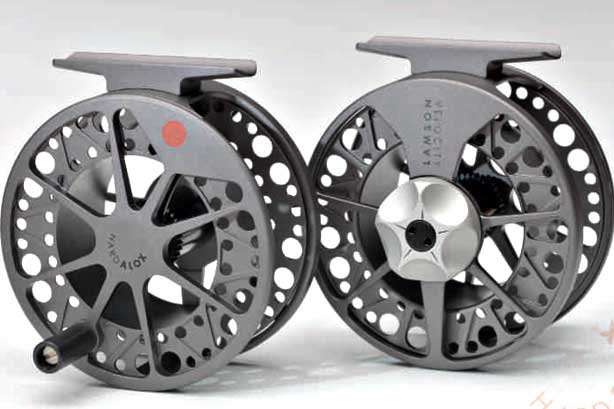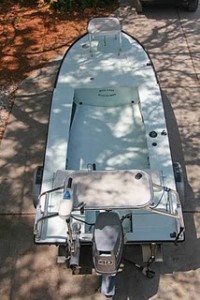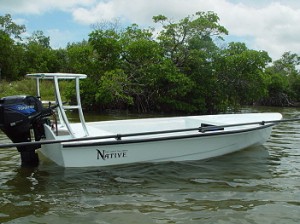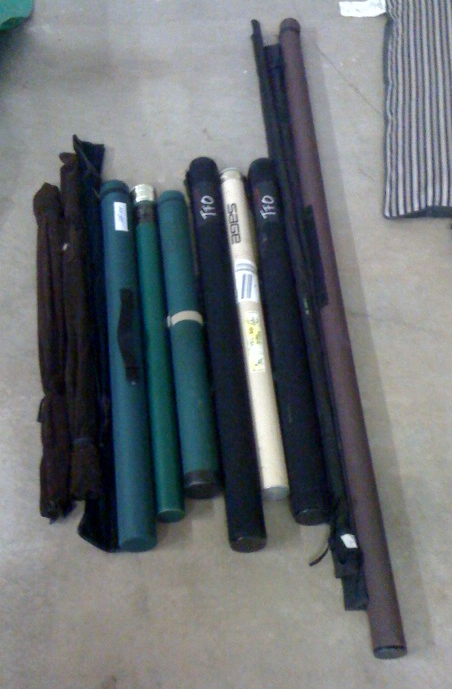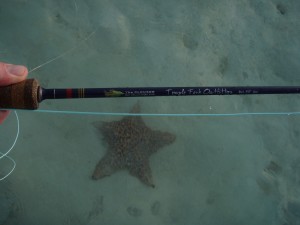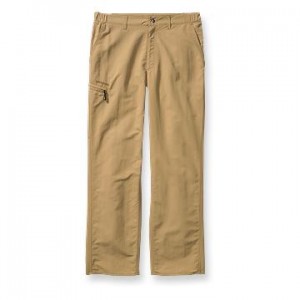There probably isn’t anyone that knows as much about bonefish as Dr. Aaron Adams. As Director of Operations for the Bonefish & Tarpon Trust, Aaron is at the heart of the body of knowledge being built on bonefish. He’s an author, a TV Star (kidding, but he was in Pirates of the Flats) and an angler. Aaron agreed to answer some questions about bonefish. These questions were given to Dr. Adams before the BP Oil Spill, so there are no spill related questions included here, although you can keep up to date on the spill at BTT’s oil spill news page.
(you can follow Dr. Adams on Twitter and he has his own website, A Fisherman’s Coast)
Aaron, as Director of Operations for the Bonefish & Tarpon Trust, you have a really unique perspective on the state of Bonefish. What does the big picture look like?
Well, we are working hard with others to make sure it is a good outlook. Some areas have seen a reduction in the numbers of bonefish, and at least some of this looks to be the result of habitat loss or degradation. We are working hard to obtain the information needed by resource management agencies to come up with effective conservation plans. It is encouraging to see that countries like Belize see the big picture, and have taken actions such as making bonefish, tarpon, and permit catch and release only. Now we need to help them find funds for enforcement and education. We definitely need to do a better job of getting the fishing industry involved, after all, their business depends on healthy fisheries. It will be a long-term, and ongoing effort, but overall I think things look good as long as we able to keep up the momentum we’ve developed. I think one of the keys is that we have developed Research Frameworks that help guide our efforts, focus funding, and be proactive.
http://www.tarbone.org/research-programs/research-frameworks.html
Pirates of the Flats was a great program. Do you have a favorite memory from that experience?
I’m glad you like the series. They did a fantastic job with it, especially incorporating the conservation message in a low-key way. I hope that the success of Pirates will serve to change the way other fishing shows are produced. A second season is being shot this summer, to air on the Outdoor Channel in early 2011. Stay tuned to www.tarbone.org for updates.
While filming, two things made the show work – the easygoing nature of the celebs and the amazing professionalism of the camera crew. The celebs were fantastic at getting the message across without being overbearing, and were great in dealing with the camera crews. Each fishing boat had two anglers, and was shadowed by a second flats boat that had two camera guys. At times, a camera guy transferred to the fishing boat to get close-ups. As you know, stealth on the flats is essential, but the camera guys were so good that this was never a problem. It was also nice that the weather during the filming days was perfect.
I really enjoyed the fishing on the Abaco marls. Although the fish are not typically large, they do come through in schools, as tailers, as singles and pairs. So they provide perfect opportunities for sight fishing. It was common to get double hookups, or be tagging a fish as the guide says to hurry up because more fish are coming.
As I’m sure you saw on the Pirates series, my blown shot at a huge bonefish was caught on tape. I was hopeful that they wouldn’t include that in the final cut, but they did, so now everyone knows about the big one that got away. At least I have witnesses.
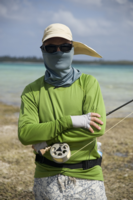
Aaron as a Pirate of the Flats
I’ve found your book on saltwater prey very helpful for fly tying. Out of all the prey species in your book, what would you say is the most overlooked?
I don’t know that any particular prey species is overlooked, but rather the connection between prey species and habitat is not well understood by many anglers. For example, there are enough mantis shrimp patterns on the market now that people know that bonefish eat mantis shrimp, and many anglers have mantis shrimp patterns in their fly box. But many anglers tie on a mantis shrimp pattern without taking a look around to see if the flat they are fishing might be good mantis shrimp habitat.
When fishing on a sand flat, for example, a quick scan of the bottom will tell you if mantis shrimp are present – mantis shrimp make those perfectly round, quarter-size holes in the bottom. Whenever I see those burrows, I tie on a mantis shrimp pattern. Similarly, those ski mogul-type mounds on some sand flats are made by various species of shrimps commonly called ghost shrimp. A tan mantis shrimp imitation will be close enough to a ghost shrimp to fool a bonefish.
Another overlooked aspect to fly selection to imitate prey is the local or regional difference. For example, in the Florida Keys large bonefish really seem to prefer toadfish, yet very few anglers who head to the Keys have any toadfish patterns in their fly box. As a matter of fact, at various times fly distributors have carried toadfish patterns in their collections, but have discontinued the patterns because they didn’t sell. When fishing seagrass beds in the Keys, I often start with a toadfish pattern.
The list goes on, but the key here is that a big part of matching the hatch for bonefish is to understand the interaction between habitat and prey. I’ve covered this to a great extent in my two books Fisherman’s Coast and Fly Fishermans’ Guide to Saltwater Prey (http://www.fishermanscoast.com/books/books2a.html), but I see a need for a third book that goes into even more detail and specifics. The work for that book is underway.
What is the next big issue in bonefish conservation on the horizon?
I see two big issues – habitat protection and responsible fishing.
Regarding habitat protection, there are intense and growing pressures on coastal habitats in many locations where bonefish are found. In Belize, for example, multinational companies are working on plans to develop coastal areas, including (believe it or not) offshore mangrove cays. Development of the offshore cays requires the sand from surrounding flats to be dredged and used as fill to provide sufficient land for buildings on the cays. This not only destroys the habitat provided by the mangroves, but the surrounding flats as well. To their credit, the current Belize government is working toward a nation-wide conservation plan to address this. Similarly, the development pressures for The Bahamas are increasing at a rapid pace. Rumor has it that there are many new developments in the planning stages, some of which will directly impact bonefish habitats.
One of the challenges with this is that in many locations we don’t have sufficient data on the bonefish fishery or on essential habitats. This is why things like juvenile habitat identification are so high on our priority list. This is also why we recently funded a study on the economic value of the bonefish fishery in The Bahamas, so that the fishery is given a fair shake in evaluations of development impacts/benefits.
From an angler’s perspective, we are eventually going to run out of new hotspots to travel in pursuit of bonefish. Already, there are locations where the bonefish fishing is not as good as it was because of habitat degradation. As I often say, either we get involved now in fisheries conservation or whine about the loss of the good ol’ days later.
A second aspect is the behavior of anglers. Catch and release is a very effective conservation strategy for bonefish (and tarpon and permit), but only if it is practiced correctly. Treating fish poorly greatly decreases their chance of survival. You can download a pdf of the BTT Best Practices for Bonefish Catch and Release here:
http://www.tarbone.org/images/stories/bonefish_brochure-inside.pdf
The bonefish tagging program revealed at least one bonefish crossing the Gulf Stream. Have there been other tags that have given surprising information?
At last check, the Florida Keys bonefish tagging program (run by the University of Miami) had tagged over 7,000 bonefish and recaptured over 300. Of these, two were recaptured on North Andros, Bahamas. The extent that these recaptures reflect a common occurrence or were outliers is unclear. Bonefish are certainly capable of migrating long distances (length of the Keys, for example, or across North Andros multiple times), but these other long distance migrations were made over shallow habitats, not deep open ocean. We have learned in the past year that bonefish spawn offshore at night, near full and/or new moons, so perhaps in rough weather some fish get lost and end up in another location? So far, it looks like, the majority of tagged bonefish are recaptured near where they were tagged, but that there are some long-distance movers.
The question then becomes – are these long distance movements associated with spawning, do some fish just have the wander-lust gene? We are now tagging in multiple locations in The Bahamas and Belize, so in the next few years we should have a better idea of typical bonefish movement patterns.
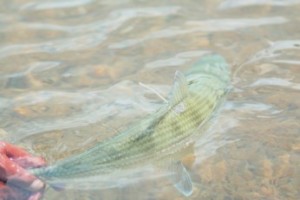
Tagged Bone
One of my favorite questions… since you are out on the water a lot you have more opportunities to see things that others just don’t… odd things, strange things, frightening things. Is there one thing you’ve seen out there on the flats that might fit into one of those categories?
Hmmm. Loaded question. Some memorable sights:
– two hammerhead sharks more than 12’ long, chasing something (never saw the object of their pursuit) on a shallow flat. The water was so shallow that their backs were exposed. We were fishing for bonefish (from a boat, fortunately), but stopped to watch the show for about 5 minutes before the sharks headed to deeper water.
– A couple days later, just back in the boat after wading for the afternoon, we saw a 9’ tiger shark cruising up onto the flat.
– On a trip to an undisclosed destination, I woke up one morning to dark skies, rain, some thunder and lighting. The lightning subsided, so I decided to go fishing. Walking sand flats with the darkest skies in the background, I was able to see pretty well. It ended up being the best fishing of the trip.
– I once caught a 7 pound bonefish that had a scar that was the perfect shape of a large barracuda. The barracuda had grabbed the bonefish from the top. The scar was old enough that scales had grown over it, but was still pretty obvious. Talk about a lucky fish!
– Large bonefish (=>7 pounds) chasing crabs in water so shallow they had to almost crawl across the flats to get to the crabs, the fish’s bodies were half exposed. Better yet, they ate flies! Amazing sight.
– some more ramblings on fishing here:
http://www.fishermanscoast.com/writing/Writing1.html
What’s your favorite bonefish rig?
I typically throw a 9’, 8 weight rod with a floating line. I start with a 9’ leader, and add on a longer tippet if the bonefish are spooky. For tailing bonefish, I typically start with unweighted crab patterns. For cruising bonefish I use flies weighted with beadchain, and then add the lead eyes for deeper running fish. You can see my standard selection of bonefish flies here:
http://www.fishermanscoast.com/flies/bonefish_fly_selection.html
Overall, I prefer a rod that I can feel load. Too many rods are too stiff (fast), and although they can shoot line they are kind of impersonal for casting. For rods, I use either a St. Croix Legend Elite or an Orvis Helios.
For reels, it’s tough to beat the Lamson Litespeed for best bang for the buck, and I was pleased with the Orvis Mirage when I recently tried one.
For fly lines, I typically use SA bonefish or tropical core lines, or similar models of Cortland lines.
A lot of people speculate about where the first 20 pounder will come from. Do you have any thoughts about the contenders and the likelihood the record will fall in 2010?
I’m not going to fall for that one! I’ve seen some very large bonefish, but never one at 20 pounds, but I’m still not giving up my favorite big bonefish spot. If it comes on a fly, it will mean that absolutely everything went right.


